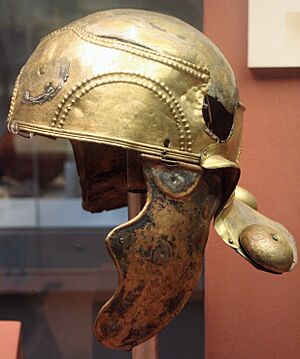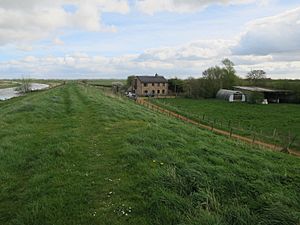Witcham Gravel helmet facts for kids
Quick facts for kids Witcham Gravel helmet |
|
|---|---|

Witcham Gravel helmet
|
|
| Material | Iron, tin, copper alloy |
| Created | c. 50–75 AD |
| Discovered | c. 1870s Witcham Gravel, Cambridgeshire |
| Present location | British Museum |
| Registration | 1891,1117.1 |
The Witcham Gravel helmet is a special Roman cavalry helmet from about 2,000 years ago. It was worn by a Roman soldier who rode a horse. Today, only the fancy outer part made of copper alloy remains. The inside was once made of iron, but it has rusted away over time.
This helmet looked very shiny and impressive. It was covered in a thin layer of tin, making it look like silver. A band around it looked like gold. What makes this helmet truly unique are the three hollow bumps, called bosses, on its surface. No other Roman helmet found so far has these features. They might have been just for decoration.
The helmet was found in the 1870s in a place called Witcham Gravel in England. It was discovered while people were digging for peat, which is like very old, decayed plant material. Today, you can see this amazing helmet at the British Museum in London.
Contents
What Does the Helmet Look Like?
The Witcham Gravel helmet is made up of several parts. These include a cap for the head, a piece for the forehead, a neck guard, and two cheek guards. Only one cheek guard is still left. All these parts are made of a copper alloy.
The cap, neck guard, and cheek guards were covered in tin. This made them look like silver. The parts were attached to an iron helmet underneath. This iron part has now rusted away. The remaining pieces are mostly for decoration. They are made of thin metal. This thin metal was easy to decorate with special patterns.
Unique Decorations
The helmet has unique designs made by pushing out the metal from behind. This technique is called repoussé. There are four half-circle designs on the forehead and back pieces. Lines of repoussé work also decorate the helmet.
The most special part of the helmet is the three hollow bumps, or bosses, on the neck guard. These bosses were attached with both solder and rivets. Rivets are like strong metal pins. These rivets also helped hold the copper alloy parts to the iron helmet. There were likely other bosses near the ears and at the front.
Missing Crest
The helmet would have also had a crest on top. A crest is a decorative plume or brush. Marks on the top of the helmet show where a crest box used to be. This box was about 20.5 centimeters (8 inches) long. It was held on by six rivets. The crest box was probably made of wood and horsehair. These materials have decayed over time.
How Was the Helmet Found?

The Witcham Gravel helmet was found around the 1870s. It was discovered during peat digging. Peat is a type of soil made from decayed plants. It was found in a place called Witcham Gravel. This area is in Cambridgeshire, England.
The exact spot where it was found is not known. But it was said to be about 4 feet (1.2 meters) deep. At that time, Witcham Gravel was a large area. Much of it was covered by fens, which are like marshy wetlands.
Early Exhibitions
By 1877, the helmet was owned by a man named Thomas Maylin Vipan. He showed it to the Society of Antiquaries of London. This is a group that studies old things. Later, in 1880, the helmet was shown again. This time it was at an exhibition of helmets and mail. A newspaper called The Academy described it as "a Roman helmet of great interest." They thought its unusual design might have been made in Italy.
Where It Is Now
Thomas Vipan died in 1891. The British Museum then bought the helmet from his family. It has been part of the museum's collection ever since. In 1993, the helmet was shown in an exhibition in France. As of 2021, you can see the helmet in Room 49 of the British Museum.
What Type of Helmet Is It?
Experts believe this helmet was made around 50 to 75 AD. This is based on the shape and angle of its neck guard. It is known as an auxiliary cavalry helmet. Auxiliary soldiers were not full Roman citizens. Cavalry means they fought on horseback.
The Witcham Gravel helmet is unique. It is the only example of its kind. It has a larger, sloping neck guard. This makes it different from other similar helmets.
Etruscan Connection
The hollow bumps (bosses) on the helmet are very unusual for Roman helmets. However, they might have been inspired by older helmets. Some helmets from the Etruscan civilization had similar bosses. The Etruscans lived in Italy long before the Romans. Their helmets were made around 600 BC.
Etruscan helmets with bosses have been found in museums today. These older bosses were filled with lead. This would have helped to protect the wearer from sword blows. But the bosses on the Witcham Gravel helmet are hollow. This suggests they were mainly for decoration, not for protection.

